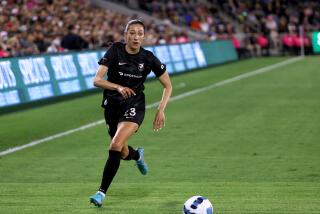Even Strong Women Can Be Weak in the Knees
- Share via
WASHINGTON — No one believes I tore my anterior cruciate ligament (ACL) in such a goofy way. I wasn’t skiing at Gstaad or coming down from a jump shot when it happened early this year. I wasn’t performing a soccer cross-kick or a tricky gymnastics move. I was sledding in Baltimore.
Still, the accident put me in good company. Some prominent ACLs were blowing out at about the same time. One star after another crumpled during the run-up to the women’s college basketball Final Four: Connecticut’s Shea Ralph, Purdue’s Erika Valek, Tennessee’s Tamika Catchings, even the Houston Comets’ Sheryl Swoopes, the Michael Jordan of the WNBA. It was the Spring of the Wounded Knee. Not to be outdone, in a May episode, Homer Simpson ACL-ed.
The audience for my knee event was much smaller: my husband, my 7-year-old son and a neighbor, Dave. The location: a really big hill, with a nice bump at the bottom, where you can catch air.
We started way up at the top, to get up maximum speed. Dave sat at the front of the toboggan, and I plopped down behind him.
“What do I do with my legs?” I recall asking. I was too shy to wrap them around his waist, Kama Sutra-style. I should have just knelt behind him. Instead, I let my legs stick out on either side of him, and off we went. As we picked up speed, they bobbled and bounced. Then, at the bump, my left leg caught on something, maybe just a lump of snow.
I felt a blinding pain in my knee. It wasn’t the classic ACL pop--it was more like a snap. My knee had just been bent in a way knees are not meant to bend. My hip didn’t feel too great, either.
While a Baltimore Sun photographer snapped away, taking Happy Snow Day pictures, I limped off to Dave’s minivan, barely able to put weight on the injured leg. “Probably just a bad sprain,” I said.
Ligaments are the tough bands of fiber that connect bones. Just about 2 inches long, the ropy little ACL extends from the back of the thigh bone (the femur) to the front of the main shin bone (the tibia). By keeping the top of the tibia from pulling away from the femur, the ACL helps stabilize the knee during twisting and pivoting movements.
For more than a decade, ACL tears have been on the rise in the United States, especially among women and girls. The stampede of women into various sports over the last 30 years is partly accountable, but researchers now agree that something more has been going on: A post-pubescent woman engaged in jumping and pivoting sports is two to eight times more likely to tear her ACL than her male counterpart in the same sport, according to studies conducted by the National Collegiate Athletic Assn. and others.
The ACL gender gap has been best documented in sports such as basketball, soccer and volleyball. Classic tear situations include coming down from a jump shot or doing a step-over in soccer--moves involving landing, stopping or cutting back and forth. Male ACL injuries generally involve contact with another player, but most female tears don’t.
“It’s a plant and a pop,” says Marie Williams with a sigh. She has seen her share of blown knees as a girls’ basketball coach at St. John’s College High School in Washington, D.C. “I’m getting so all I have to do is see it, and I just know.”
To an athlete or even a moderately active person, tearing an ACL is devastating. Without surgery, a person can recover enough to walk but generally not much more--the knee will always be unstable and prone to arthritis. Reconstructive surgery and extensive rehab now enable most athletes to resume their careers, but some never recover fully.
At the start of the 1980s, ACL tears numbered about 100,000 a year in the United States; today that figure is probably double, estimate some orthopedic surgeons, including Bernard Bach Jr., professor of orthopedic surgery and the director of sports medicine at Rush-Presbyterian-St. Luke’s Medical Center in Chicago. Exact numbers are unavailable because some people don’t seek treatment.
The gender disparity in tear rates is confounding researchers and scaring athletes, parents and coaches--not just at the professional and collegiate level, but in high school sports as well. About 20,000 high school athletes per year--a disproportionate number of them female, after controlling for play hours--now get ACL tears, according to the American Orthopaedic Society for Sports Medicine, based in Rosemont, Ill.
Players and coaches often view the injury warily, almost superstitiously, fearful of inviting a tear simply by talking about it.
“No question, it’s the scourge of the sport, a dark shadow, a cloud,” says Richie Burke, who coaches girls’ soccer at the National Cathedral School (NCS) in D.C.
In the three years that Burke has been coaching for NCS (and a powerhouse under-18 club team, the Bethesda, Md., Falcons), five of his athletes have blown their ACLs, including one 17-year-old who already has had three tears.
The tearing of knee ligaments is an issue confronting young athletes all over the country. Dallas public schools, for instance, have recorded 45 ACL injuries so far this year.
“An eighth-grader jumps up to spike a ball, comes down and tears her ACL. Why does that happen?” asks a frustrated Phil Francis, head trainer for the Dallas Independent School District. “Why can’t she jump without that happening?” Francis says he plans to start an anti-tear training regimen for girls next year: “We’ve got to do something.”
So what did having a shredded ACL mean for me?
It was scary. I played varsity basketball in high school and college, and I still like running, hiking, biking, volleyball. Would I be able to do all these things again?
What I learned reassured me.
An ACL tear used to spell the end of a sports career, but these days, thanks to advances in surgical technique and rehabilitation, many athletes return to their previous level of performance.
My doctor, Andrew J. Cosgarea, assistant director of sports medicine at Johns Hopkins, laid out my prospects:
A week or two of pretty bad post-surgical pain. Months of therapy. Within 12 weeks, maybe some slow jogging. Within four to eight months, maybe something more challenging, like a little gentle half-court basketball action. As long as I faithfully rehabbed, I had a 90% chance of resuming my previous level of athletic activity.
Of course, there was no guarantee. I knew there had been bad outcomes. Take University of Connecticut basketball great Rebecca Lobo, whose repeat ACL injuries pretty much derailed her career. I preferred to dwell on the success stories, like soccer pro Brandi Chastain or actress Michelle Yeoh, star of “Crouching Tiger, Hidden Dragon,” who blew her ACL at the beginning of that movie’s filming. (Yeoh had reconstruction, rehabbed like crazy and resumed work on the physically demanding project after only three months--an extremely short recovery.)
My first two big choices were whether to have surgery (yes!) and what kind of graft to use. Surgeons can make a new ACL with tissue from the patient’s own body--an autograft, generally preferred--or tissue from a cadaver--an allograft. (Synthetic substitutes, like Gore-Tex, have so far proven disappointing.)
The two most common grafts these days are a piece of the patient’s own patellar tendon (under the kneecap) or some of the hamstring tendons (those taut bands you can feel under your knee). The possibly sturdier patellar graft is what Cosgarea recommends for professional athletes, but it can be painful and more difficult to recover from. Recovery is easier with the hamstring procedure, though it somewhat diminishes the hamstring’s strength. Two of the five hamstring tendons are harvested; the idea is that the other three can compensate.
On Cosgarea’s advice, I chose the hamstring graft. That surgery generally goes like this:
The hamstring tendons are removed via an incision below the kneecap. Folded over, they form a multi-strand band that is inserted into “tunnels” drilled in the femur and the tibia.
The graft, in my case, was anchored in the femoral tunnel with a sort of metal button and into the tibial end with a screw that is “bio-absorbable,” meaning it eventually merges with the bone. Getting the proper tension on the graft is tricky--too tight and the knee will be hard to straighten, too loose and it will be floppy.
Immediately after surgery--about a month after the accident--my knee was hot and swollen. Ice and pain killers, stat!
One early rehab goal is to get the knee to bend completely--to achieve a good “range of motion,” in therapy-speak. The other early task--oddly enough--is getting the knee to straighten. What the knee basically wants to do is kink up and hurt.
Therapy soon settled into a three-day-a-week routine of leg lifts, stationary biking, leg presses, wall slides, stair-climbing and other exercises. From all the bed rest and walking on crutches, the quadriceps muscle on my injured leg remained stubbornly weak, and a bit atrophied.
“Why is one leg fat and one leg skinny?” my young niece asked when she saw me in a bathing suit.
That’s changing, but slowly. I walk pretty smoothly now (as I should, 12 weeks post-op). With my hinged metal brace, I can even jog slowly, if asymmetrically. But when I’m going up steps, I move like a rusty robot on a weak joint.
So, I’m cranking harder with my therapy. No more slacking off on the weekend. We’ll see. Sometime this summer, I hope to be running smoothly, chasing my son around the front lawn and actually catching him.
And maybe I’ll even jog past that big sledding hill.
(BEGIN TEXT OF INFOBOX / INFOGRAPHIC)
The Anterior Cruciate Ligament
The ACL is one of four ligaments that stabilize and make movement of the knee possible. There are collateral ligaments (not shown) on each side of the knee and two crossing ligaments deep inside the knee--the ACL on the front and the posterior cruciate ligament, or PCL, on the back. These attach to the end of the thigh bone (the femur) and the top of the shin bone (the tibia).
*
Source: Johns Hopkins University department of orthopaedic surgery
More to Read
Go beyond the scoreboard
Get the latest on L.A.'s teams in the daily Sports Report newsletter.
You may occasionally receive promotional content from the Los Angeles Times.










